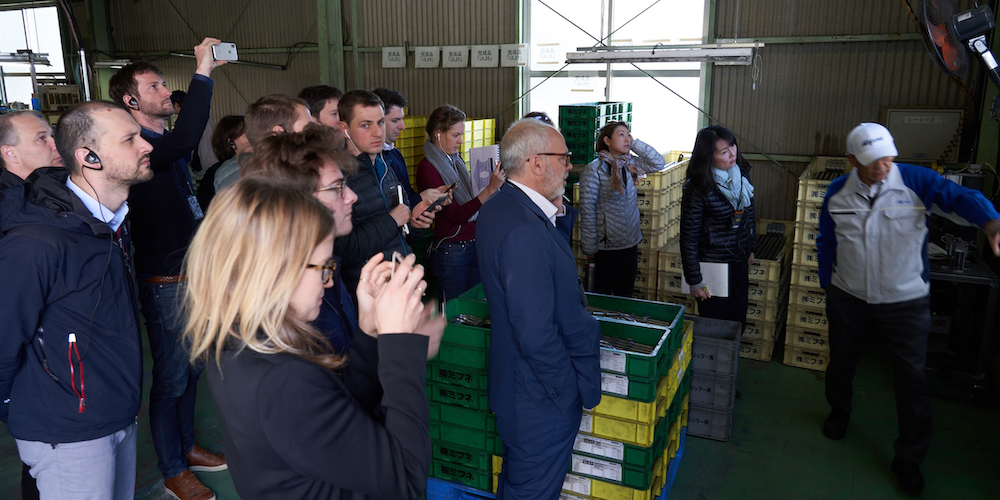
What my Toyota mentors taught me about problem-finding
FEATURE – Introducing his book, the author tells us what his Toyota mentors taught him with their contrasting, but ultimately complimentary approaches to problem finding.
Words: Nate Furuta
I joined Toyota in 1970 after graduating from the University of Tokyo with a bachelor of law degree, but I was in no way destined to work for Toyota nor equipped with a kaizen mind. (Contrary to popular belief, not everyone who is hired by Toyota is a lean thinker to begin with!)
I was assigned to Human Resources. Two executives there helped to shape my problem finding and problem solving abilities: Kenzo Tamai and Iwao Isomura. I worked for both within Toyota Human Resources as I developed proposals to address union demands and resolve grievances at our Japan plants. This work took me to every imaginable area of Toyota, forcing me to understand processes as if I were working the line (union perspective) or managing team members (company perspective).
Mr. Tamai taught me to analyze data and phenomena in order to clearly identify a problem, to accurately see facts, and to build countermeasures from those facts. My proposals to Mr. Tamai were repeatedly returned, crossed in red ink: I had not collected enough facts from the workplace to support my solution to a problem, to properly identify root causes, or to even define the problem correctly.
Mr. Tamai’s network kept him in regular communications with the workforce – he knew a thousand individuals by name – and he often knew the facts far better than those working under him could hope to discover. Based on information from his many contacts, he could have told me what was wrong with my proposal, but he did not. With repeated failures, I would check the facts again and again, returning to the workplace, listening to people, observing the physical conditions – even late at night to see the second shift.
Mr. Tamai was very logical and pragmatic, in order to ensure that a proposal would be accepted by the union and related departments. He encouraged me to be likewise: “Furuta, your fact finding is weak, your root cause analysis is insufficient, and your execution plan is not well thought through. Think deeper and come back with a better idea.”
One day, I was really struggling with how to solve a union demand. Mr. Tamai told me to try and see the data from an entirely different perspective, which opened my eyes to the actual problem and led to a proposal that the union accepted. Over time I fought through his red ink and finally developed a successful proposal. As evidence of Mr. Tamai’s approval, late one night after the union agreed to our proposal, I found a bottle of Johnnie Walker in my desk drawer.
In 1985, Mr. Tamai, as the head of HRM in Toyota, gave me full discretion to negotiate the all-important labor contract for NUMMI (Toyota-General Motors joint venture, New United Motor Manufacturing) with the UAW in North America without headquarters approval: a humbling vote of confidence from teacher to student.
My other teacher, Mr. Isomura, taught me to take a bird’s eye view of problems. He was famous for taking the most complicated issue, quickly finding its substance, and ensuring that solutions clearly addressed the original problem. The speed with which Mr. Isomura worked and his big-picture perspective fit my nature.
While working with him I resolved a union demand in Japan to establish a 10 billion yen family-welfare fund for Toyota employees. Toyota considered the demand impossible because of the impact from taxes on funding and the interest, but by examining all possibilities of Japanese tax exemptions (bird’s eye view) and analyzing every fact conceivable (carefully reviewing existing pension fund regulations), I negotiated with the Japan Treasury and the Ministry of Welfare to establish the Toyota family-welfare fund without any taxation. This fund is the only one of its kind in Japan because the government changed its interpretation of the law immediately after Toyota established the fund. (I once heard that Mr. Isomura regarded me as one of the top three individuals in Toyota he wanted for difficult tasks. He passed away before I could ask him who the other two were.)
The mentoring of Mr. Tamai and Mr. Isomura provided me with two contrasting but complimentary problem-finding skills, both of which served me well as I sought out and tackled the massive problems at Toyota (I write about each of them in my newly-published book Welcome Problems, Find Success: Building Toyota Cultures Around the World):
- Leading labor negotiations in the early-1980s with the UAW to establish the Toyota-General Motors joint venture NUMMI in Fremont, California.
- Starting Toyota’s first greenfield plant in North America in the late-1980s in Georgetown, Kentucky.
- Organizing corporate Toyota to better address globalization by establishing Toyota Motor North America manufacturing headquarters in Erlanger, Kentucky in the 1990s.
- Leading management to support Toyota DNA to reinvigorate manufacturing organizations, including sagging Georgetown at the turn of the century.
- Reviving Toyota’s failing European division in the early 2000s.
Each of these roles presented myriad challenges for Toyota, and it was my job to find the problems behind these challenges and to clarify and resolve them. How I did that – and enlisted those around me to find and solve problems that aligned with Toyota’s vision – helped me to better understand kaizen culture and what is needed to build a company of problem finders.
Read about Nate Furuta's outstanding experience exporting Toyota cultures to environments as diverse as NUMMI and the company's European operations.



THE AUTHOR
Nate Furuta is author of Welcome Problems, Find Success - Creating Toyota Cultures Around the World. He has 38 years of experience working for Toyota, helping the organization establish some of its most challenging ventures around the world
Read more


FEATURE – How can digital companies develop a competitive edge in the "tech first" future? By using Lean Thinking to ensure continuous learning and transform the way coders think and work.


CASE STUDY – From client and supplier to partners-in-lean: how solving a problem together transformed the relationship between a Dutch hospital and the laundry supplying clean garments to it.


FEATURE – Digital organizations are starting to recognize that Toyota’s unique approach can show them the way forward, just like it does “traditional” organizations. Here, we hear from a few startup CEOs following their trip to Japan.


FEATURE – This article explains how Lean Thinking and the agile method can strengthen and optimize our digital transformation efforts.

